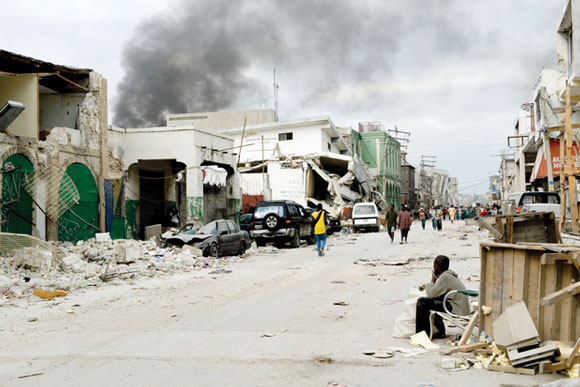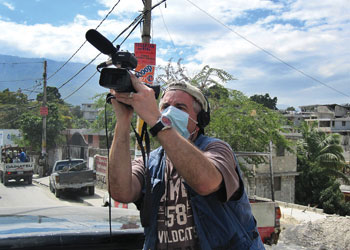by Kara Petrovic // Fall 2010

When the streets stood still and dusty smoke blanketed survivors of last January’s earthquake in Haiti, devastation was all that remained in the western hemisphere’s poorest nation. It only took seconds for the quake’s sheer force to topple concrete-block homes and businesses, leaving behind mountains of rubble, more than 200,000 Haitians dead and another 300,000 seriously injured on the island of about 9 million people.
Official reports deemed the 7.0 magnitude earthquake — centered about 10 miles southwest of Haiti’s capital city Port-au-Prince — the most powerful quake to hit the country in more than a century. Haitians are still recovering from the catastrophe nine months ago, and, as two UMKC faculty members shared from their recent visits to Haiti, the destruction remains, as do the strong emotions they have carried since returning home. Yet for husband and wife School of Medicine alumni, a trip so soon after the quake didn’t feel right. They remained behind grieving for a country they’ve loved and supported for more than 20 years.
This emotional roller coaster left them all wondering how to best use their own talents to
give back, and now, with their individual visits back to Haiti approaching, they finally have the answers. These are their stories and dreams for a better Haiti.

A teaching tool
As aftershocks shook Haiti, Peter Morello, associate professor of journalism in the Communication Studies Department at UMKC, found himself in the epicenter within two weeks of the quake. Catastrophes are not new to Morello. As an international correspondent and producer for Public Broadcasting Service (PBS) for 15 years, his coverage included the breakup of the Soviet Union, the war in Bosnia and famine relief efforts in Somalia. Morello joined UMKC in 1999. He thought his prior knowledge and experience would prepare him for Haiti, but Morello says the country’s condition was beyond anything he’d seen in his career.
“When I saw Haiti, I likened it to the bombing of Dresden during World War II,” he says. “There was devastation with massive pockets of rubble everywhere. It was difficult to maneuver. I’d never been to Haiti before this, and it’s hard to compare troubled regions that I have visited to Haiti because they are all different. However, I can tell you that I’ve never seen so much destruction on a mass scale.”
Days after the earthquake, Morello says he received a call from a local church asking him to accompany two members to Haiti who wished to aid in the relief efforts. The church knew of Morello’s documentaries, national awards and correspondent work that appears regularly on Kansas City Public Television (KCPT-19). “While they were there laying the groundwork for relief efforts, I was there laying the groundwork for a documentary,” Morello says. “What I saw at that time was that the Haitian people have very specific needs and still do. Haiti is going to be a long-term project, and I estimate that it will take 20 years to rebuild this country. I didn’t go to Haiti for myself, but for the people of Haiti.”
Morello says his week filming in Haiti was an experience he’ll never forget, but notes that it wouldn’t have been possible without the support he received from Communication Studies Department Chair Carol Koehler and the College of Arts and Sciences Dean Karen Vorst. “The department supported my efforts and gave me a little bit of funding to go,” he says. “And after returning, I shared all of my information with three different journalism classes.
What this did for students was very impactful. It taught them that even if they don’t know much about an area or region, awareness is the best tool they can have if they blend it with the skill sets they’ve developed here at school. I like to think that my experience taught them to develop goals early and to stick with them. I continued to remind them that as a guy in my 50s, I was able to travel to a new country where I didn’t know the language because of the skills I have. And if I could do it, they can certainly do it at their age.”
Morello says he plans to return to Haiti to finish his documentary work on faith-based relief groups and will cover both U.S. and Haitian efforts. He hopes KCPT and regional PBS will broadcast it to coincide with the country’s first anniversary after the quake. “I’m going back for the right reasons,” he says. “I’m going back for the people of Haiti. It’s a journalism basic that the best stories are stories told through people. The Haitians are very resilient people, and they’ve been through a lot and have learned how to adapt. This is a chance for them to share their stories.”
